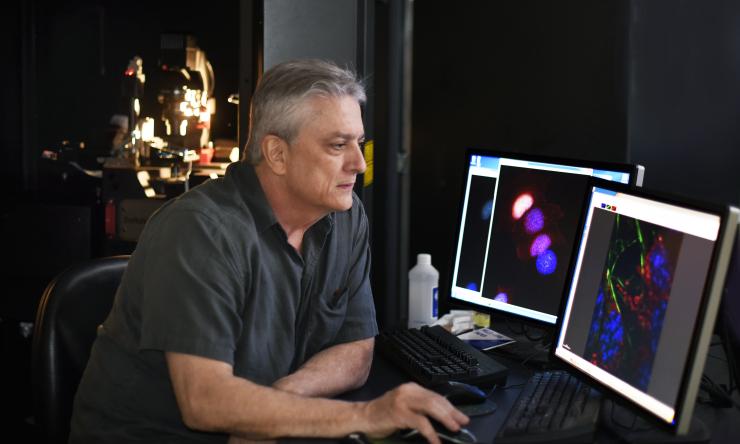Cell Painting identifies flavonoids that are toxic to bladder cancer cells
A team led by researchers at ˛ÝÁńÉçÇřČëżÚ has identified flavonoids, natural compounds found in plants, that are toxic to bladder cancer cells cultured in the lab. The researchers report in the journal that Cell Painting technology enables them not only to identify compounds with potential anti-cancer properties but also uncover insights into their mechanism of action.
“Cell Painting uses high-throughput microscopy to highlight cellular structures and, via custom image analysis pipelines, quantify changes in cultured cell populations,” said corresponding author Dr. Michael Mancini, professor of molecular and cellular biology and director of Baylor’s long-running Integrated Microscopy Core and the Gulf Coast Consortium Center for Advanced Microscopy and Image Informatics (CAMII, co-located at Baylor and the Texas A&M Institute for Bioscience and Technology). “This innovation enables a more detailed understanding of how drugs interact with cells, revealing changes in the characteristics of a cell and its individual internal structures.”
Cell Painting analysis purposefully generates very large datasets (more than 57,000 high-throughput confocal images per plate being scanned), which are impossible to collect manually and are inherently difficult to analyze at the individual cell level, especially when lacking large computer processing resources.
, Mancini and his colleagues reported the development of a powerful computational tool called SPACe, for Swift Phenotypic Analysis of Cells, to individually analyze thousands of cells among dozens of plates and also report on subpopulation heterogeneity. Importantly, due to streamlined programming, it is now possible to analyze large-scale drug screening data sets on a standard desktop computer, which makes this process available to laboratories of varying sizes.
“With this powerful tool in hand, we analyzed 244 flavonoid compounds for bladder cancer cell toxicity,” said first author Dr. Michael J. Bolt, assistant professor of molecular and cellular biology at Baylor. “Bladder cancer is the fifth most common cancer in the United States, and it causes more than 16,000 deaths annually. Although current treatments help remove the tumors and control relapses, issues persist with residual cancer that could spread further. In this study, we assessed the value of Cell Painting to identify novel flavonoids that could potentially be developed into new therapeutics to improve bladder cancer treatment.”
The team tested the flavonoids in three common bladder cancer cell lines grown in the lab. They discovered six flavonoids that killed the cancer cells, including (as expected) two known toxic flavonoids (flavopiridol and rotenone). SPACe analysis revealed that some of these compounds killed the cancer cells by causing DNA damage while others altered mitochondrial functions, disrupting their ability to supply energy to cells.
“Importantly, we also identified three flavonoids that reduced the growth of 3D bladder cancer cultures called spheroid and chorioallantoic membrane systems, which are considered more physiological culture systems, but these flavonoids did not affect normal bladder cell growth,” Mancini said. “We also observed compounds, including deguelin, cardamonin, biochannin A and xanthohumol, that were toxic but had little or no effect on DNA features.”
“Notably, we discovered that xanthohumol-induced killing of bladder cancer cells was accompanied by a decrease in lipid metabolism in these cells and a stark reduction in the number of lipid droplets per cell,” Bolt said.
Xanthohumol is found in certain beers in amounts similar to those used in these experiments. “It would be interesting to determine the occurrence of bladder cancer in patients who frequently consume xanthohumol-rich beers,” Bolt said.
Mancini said that, “Flavonoids are found in plants that we consume for food and drink and some of these compounds may be naturally protective against different diseases. With Cell Painting screening we can now rapidly probe libraries of these compounds using SPACe to study them and uncover their potential therapeutic value.”
Future studies will evaluate the safety and efficacy of these flavonoids in living animal models of bladder cancer, including models carrying human bladder cancer tumors, and later in human clinical trials. The goal is to assess the possibility of developing some of these compounds into cancer therapies that could be a part of current treatment options and improve clinical outcomes.
Jessica Oceguera, Alejandra Rivera Tostado, Christopher D. Candler, Elina Mosa, Kazem Safari, and Maureen G. Mancini also contributed to this work. During the production of this manuscript, these authors were affiliated with one or more of the following institutions: ˛ÝÁńÉçÇřČëżÚ, the GCC Center for Advanced Microscopy and Image Informatics and Texas A&M University.
This study was supported via the CPRIT-funded GCC Center for Advanced Microscopy and Image Informatics (RP170719), the Dan L Duncan Comprehensive Cancer Center (P30 CA125123), the Texas Medical Center Digestive Diseases Center (DK056338), and the GCC Center for Precision Environmental Health (P30ES030285a).



